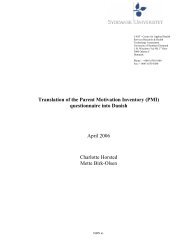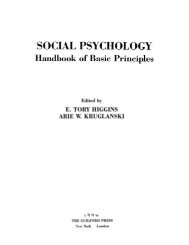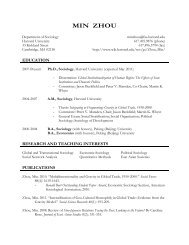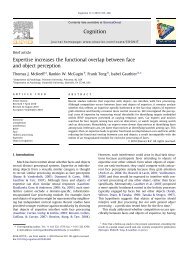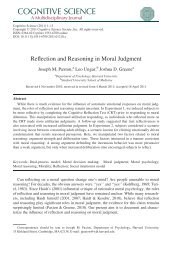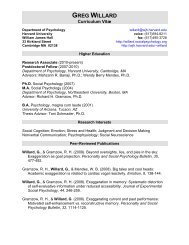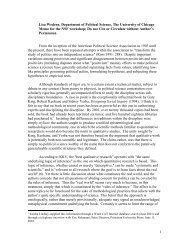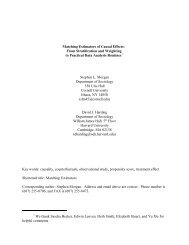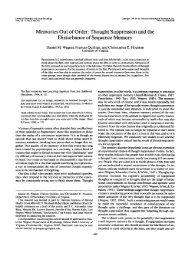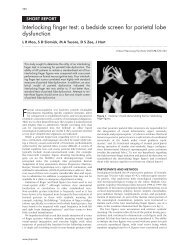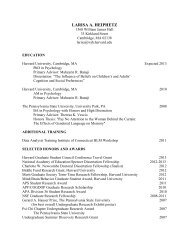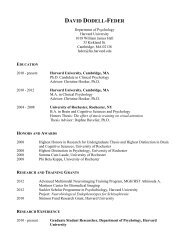Studying the "Referability" of Child Clinical ... - WJH Home Page
Studying the "Referability" of Child Clinical ... - WJH Home Page
Studying the "Referability" of Child Clinical ... - WJH Home Page
You also want an ePaper? Increase the reach of your titles
YUMPU automatically turns print PDFs into web optimized ePapers that Google loves.
Journal <strong>of</strong> Consulting and <strong>Clinical</strong> Psychology<br />
1991, Vol.59, No. 2, 266-273<br />
Copyright 1991 by <strong>the</strong> American Psychological Association, Inc.<br />
0022-006X/91/S3.00<br />
<strong>Studying</strong> <strong>the</strong> "Referability" <strong>of</strong> <strong>Child</strong> <strong>Clinical</strong> Problems<br />
John R. Weisz<br />
University <strong>of</strong> North Carolina at Chapel Hill<br />
Bahr Weiss<br />
Vanderbilt University<br />
<strong>Child</strong> clinical problems may differ in <strong>the</strong>ir power to evoke clinic referral, and this "referability" <strong>of</strong><br />
problems may also differ with <strong>the</strong> gender or culture <strong>of</strong> <strong>the</strong> child who manifests <strong>the</strong>m. The authors<br />
propose (a) a method for <strong>the</strong> study <strong>of</strong> such differences and (b) a new statistic, <strong>the</strong> referability index<br />
(RI). RI reflects <strong>the</strong> frequency with which a child problem stimulates clinic referral, adjusted for its<br />
prevalence in <strong>the</strong> general population. RI was assessed across 118 child problems as a function <strong>of</strong><br />
problem type (overcontrolled vs. undercontrolled), child gender, and culture (U.S. vs. Thailand).<br />
Problems <strong>of</strong> both types were more referable in girls than boys; undercontrolled problems were more<br />
referable than overcontrolled in <strong>the</strong> U.S. but, surprisingly, not in Thailand. The findings shed new<br />
light on gender and culture differences and illustrate <strong>the</strong> empirical and heuristic potential <strong>of</strong> <strong>the</strong> RI<br />
statistic.<br />
The study <strong>of</strong> child psychopathology is actually <strong>the</strong> study <strong>of</strong><br />
two somewhat distinct phenomena: <strong>the</strong> behavior <strong>of</strong> children<br />
and <strong>the</strong> responses <strong>of</strong> adults to that behavior. Descriptive epidemiologic<br />
research can address <strong>the</strong> first phenomenon, telling us<br />
<strong>the</strong> frequency with which various kinds <strong>of</strong> child behavior and<br />
child problems occur. However, such research needs to be complemented<br />
by research on <strong>the</strong> second phenomenon, to help us<br />
understand <strong>the</strong> significance and consequences <strong>of</strong> various forms<br />
<strong>of</strong> child behavior within <strong>the</strong>ir social context. Because children<br />
rarely consider <strong>the</strong>mselves "psychologically disturbed" and<br />
rarely refer <strong>the</strong>mselves for treatment, it is generally adults in a<br />
particular child's society who determine whe<strong>the</strong>r that child's<br />
behavior constitutes "psychopathology" and whe<strong>the</strong>r it<br />
warrants intervention. <strong>Child</strong> problems that adults do not consider<br />
serious are not likely to receive clinical attention, even if<br />
<strong>the</strong>y are very distressing to <strong>the</strong> child. <strong>Child</strong> problems that<br />
adults do consider serious may well lead to treatment, even if<br />
<strong>the</strong>y are not distressing to <strong>the</strong> child.<br />
Because <strong>the</strong> adult response so <strong>of</strong>ten determines whe<strong>the</strong>r a<br />
particular child problem will lead to mental health intervention,<br />
investigators have begun to study <strong>the</strong> attitudes and responses<br />
<strong>of</strong> adults to various forms <strong>of</strong> child "problem behavior"<br />
(e.g., Walker, Bettes, & Ceci, 1984; Weisz et al, 1988). A primary<br />
goal <strong>of</strong> such research is <strong>of</strong>ten to gauge <strong>the</strong> extent to which<br />
various child problems are likely to be considered serious and<br />
to be referred to a specialist for help (i.e., problem referability).<br />
The referability <strong>of</strong> different problems may differ from one ano<strong>the</strong>r,<br />
<strong>of</strong> course, as a function <strong>of</strong> various characteristics <strong>of</strong> <strong>the</strong><br />
This study was supported by Grant 5 R01 MH38240 from <strong>the</strong> National<br />
Institute <strong>of</strong> Mental Health, which we acknowledge with appreciation.<br />
We also thank our Thai and American colleagues, Thomas Achenbach,<br />
Wanni Wibulswasdi Anderson, Wanchai Chaiyasit, Elizabeth<br />
Jackson, Somsong Suwanlert, and Bernadette Walter, for <strong>the</strong>ir numerous<br />
contributions to this project.<br />
Correspondence concerning this article should be addressed to John<br />
R. Weisz, who is now at Department <strong>of</strong> Psychology, Franz Hall, University<br />
<strong>of</strong> California at Los Angeles, 405 Hilgard Avenue, Los Angeles,<br />
California 90024-1563.<br />
266<br />
problem (e.g., whe<strong>the</strong>r it is an internalizing or "overcontrolled"<br />
problem on <strong>the</strong> one hand or an externalizing or "undercontrolled"<br />
problem on <strong>the</strong> o<strong>the</strong>r; see early work on this distinction<br />
by Achenbach [1966]). In addition, referability <strong>of</strong> <strong>the</strong> same<br />
problem may differ as a function <strong>of</strong> child characteristics (e.g.,<br />
<strong>the</strong> gender <strong>of</strong> <strong>the</strong> child who manifests <strong>the</strong> problem) or <strong>of</strong> <strong>the</strong><br />
culture in which <strong>the</strong> problem occurs.<br />
<strong>Studying</strong> referability <strong>of</strong> child problems is a potentially important<br />
enterprise, both <strong>the</strong>oretically and practically. Consider <strong>the</strong><br />
following examples: (a) Determining which child problems are<br />
high in referability, and which are low, may enrich our understanding<br />
<strong>of</strong> those factors that make adults take child problems<br />
seriously. For instance, results <strong>of</strong> one recent study (Weisz et al.,<br />
1988) suggest that parental judgments about how serious and<br />
how much in need <strong>of</strong> treatment a problem is, are related to how<br />
troubling or bo<strong>the</strong>rsome <strong>the</strong> behavior is to o<strong>the</strong>rs, (b) Discovering<br />
that a particularly serious problem shows low referability<br />
can sensitize us to <strong>the</strong> need to educate <strong>the</strong> public, thus enhancing<br />
access by children to services <strong>the</strong>y need, (c) Finding differences<br />
in <strong>the</strong> referability <strong>of</strong> particular problems for girls versus<br />
boys may help us identify and address sex stereotypes and<br />
biases that can limit access to treatment for boys or girls, (d)<br />
Discovering cross-national differences in <strong>the</strong> referability <strong>of</strong> particular<br />
problems can enhance our understanding <strong>of</strong> cultural<br />
differences and <strong>the</strong>ir impact on mental health service delivery.<br />
In <strong>the</strong>se and o<strong>the</strong>r ways, knowing <strong>the</strong> referability <strong>of</strong> various<br />
child problems may broaden our knowledge base and enrich<br />
our <strong>the</strong>ories <strong>of</strong> child psychopathology, while enhancing children's<br />
access to mental health care.<br />
For <strong>the</strong>se reasons, it is important to <strong>the</strong> study <strong>of</strong> child psychopathology<br />
that we have accurate information on <strong>the</strong> referability<br />
<strong>of</strong> child problems. Unfortunately, efforts to generate such information<br />
have thus far relied heavily on adults' self-reports (e.g.,<br />
Likert ratings <strong>of</strong> how serious particular child problems are, or<br />
statements <strong>of</strong> whe<strong>the</strong>r <strong>the</strong> adults would be likely to refer a child<br />
with particular problems for treatment). Such self-reports are<br />
useful, but <strong>the</strong>y should not be our only source <strong>of</strong> data, because<br />
<strong>the</strong>y may be subject to possible response biases (e.g., a desire to<br />
be cautious, to appear enlightened, or to avoid <strong>the</strong>
appearance <strong>of</strong> sex bias). Apart from such systematic biases,<br />
<strong>the</strong>re is always <strong>the</strong> possibility that what adults honestly believe<br />
<strong>the</strong>y would do (when <strong>the</strong>y answer hypo<strong>the</strong>tical questions on a<br />
questionnaire) will differ substantially from what <strong>the</strong>y would<br />
actually do when confronted with a real child who has real<br />
problems. The challenge for researchers, <strong>the</strong>n, is to find an<br />
approach to studying referability that does not rely on adults'<br />
self-reports <strong>of</strong> what <strong>the</strong>y believe or what <strong>the</strong>y would do in hypo<strong>the</strong>tical<br />
situations. As a complement to <strong>the</strong> self-report approach,<br />
we propose a method that derives information about<br />
referability from <strong>the</strong> actual behavior <strong>of</strong> adults confronted with<br />
real child problems.<br />
We will illustrate <strong>the</strong> use <strong>of</strong> such an approach. In essence, we<br />
operationally define referability as <strong>the</strong> frequency with which a<br />
child problem is reported as a presenting complaint at mental<br />
health clinics, relative to <strong>the</strong> frequency <strong>of</strong> that problem in <strong>the</strong><br />
general population. The choice <strong>of</strong> this definition is based on <strong>the</strong><br />
assumption that <strong>the</strong> frequency with which a problem is reported<br />
as a presenting complaint in clinics is primarily a function<br />
<strong>of</strong> (a) <strong>the</strong> frequency with which it occurs in <strong>the</strong> general<br />
population and (b) <strong>the</strong> perception that <strong>the</strong> problem requires<br />
and is appropriate for psychological treatment. By adjusting <strong>the</strong><br />
presenting problem prevalence for <strong>the</strong> general population prevalence,<br />
one is left with <strong>the</strong> "referability" <strong>of</strong> a particular<br />
problem.<br />
This approach provides a particularly comprehensive and behavioral<br />
look at referability <strong>of</strong> child problems. It does not rely on<br />
adults' verbal reports <strong>of</strong> <strong>the</strong>ir attitudes, but ra<strong>the</strong>r on statistical<br />
analysis <strong>of</strong> <strong>the</strong> behavioral consequences <strong>of</strong> <strong>the</strong>se attitudes (i.e., <strong>of</strong><br />
<strong>the</strong> extent to which referral rates for various child problems<br />
over- or underrepresent <strong>the</strong> prevalence <strong>of</strong> those problems in <strong>the</strong><br />
general population).<br />
Beyond <strong>the</strong> study <strong>of</strong> specific problems, this approach permits<br />
<strong>the</strong> investigation <strong>of</strong> whe<strong>the</strong>r certain <strong>the</strong>oretically important<br />
child syndromes are more referable than o<strong>the</strong>rs. In our study, we<br />
focused on what appear to be <strong>the</strong> two most frequently identified<br />
empirically derived syndromes: overcontrolled problems (e.g.,<br />
anxiety, somatic problems, social withdrawal) and undercontrolled<br />
problems (e.g., disobedience, fighting, stealing). These<br />
two "broadband" syndromes have emerged from more than a<br />
dozen independent factor analytic studies <strong>of</strong> children's behavior<br />
problems (see Achenbach & Edelbrock, 1978). There is some<br />
evidence that undercontrolled problems predict more serious<br />
long-term outcomes for children (see, e.g., Patterson, DeBaryshe,<br />
& Ramsey, 1989; Robins, 1979). Recent research using<br />
adult self-reports <strong>of</strong> <strong>the</strong>ir attitudes (Weisz et al, 1988) revealed<br />
that undercontrolled problems are rated as more serious and<br />
worrisome than overcontrolled problems; yet, in that same selfreport<br />
research, Americans rated <strong>the</strong> two syndromes as equal in<br />
need for referral. Here we probed for differences in referability<br />
using <strong>the</strong> more behavioral assessment approach described<br />
above.<br />
In addition to permitting comparisons <strong>of</strong> <strong>the</strong> referability <strong>of</strong><br />
various child problems and syndromes, <strong>the</strong> approach developed<br />
here also makes it possible to investigate demographic<br />
factors that may influence referral. One such factor may be<br />
child gender. Adult attitudes toward boys and girls may make<br />
certain problems differentially referable depending on <strong>the</strong><br />
gender <strong>of</strong> <strong>the</strong> child who manifests <strong>the</strong> problems. Might an adult<br />
STUDYING "REFERABILITY" OF CHILD PROBLEMS 267<br />
belief that "boys will be boys" make fighting less referable (because<br />
it is seen as less serious) among boys than girls? Might an<br />
adult perception that girls are moody make bouts <strong>of</strong> depression<br />
or emotional lability less referable for girls than boys? To investigate<br />
such possibilities, we explored relations between child<br />
gender and referability.<br />
We also explored <strong>the</strong> possibility that referability may differ<br />
with <strong>the</strong> culture in which child problems occur. We compared<br />
two cultures that are said to differ markedly in <strong>the</strong>ir orientation<br />
toward overcontrolled and undercontrolled child problems, but<br />
about which <strong>the</strong> research evidence thus far is conflicting: Thailand<br />
and <strong>the</strong> United States. Much <strong>of</strong> <strong>the</strong> literature on mental<br />
health in Thailand suggests that Thai adults, partly because <strong>of</strong><br />
<strong>the</strong>ir Theravada Buddhist orientation, are unusually accepting<br />
<strong>of</strong> quietness, shyness, inhibition, and o<strong>the</strong>r forms <strong>of</strong> overcontrolled<br />
behavior in children, but that <strong>the</strong>y strongly disapprove <strong>of</strong><br />
disobedience, aggression, and o<strong>the</strong>r forms <strong>of</strong> undercontrolled<br />
behavior in children (see, e.g., Gardiner & Suttipan, 1977; Sangsingkeo,<br />
1969; Weisz, 1989). However, a recent study <strong>of</strong> Thai<br />
and American adults' attitudes revealed no reliable differences<br />
between <strong>the</strong> two groups in <strong>the</strong> perceived relative seriousness or<br />
need for treatment <strong>of</strong> overcontrolled versus undercontrolled<br />
child problems (Weisz et al., 1988). Fur<strong>the</strong>r complicating <strong>the</strong><br />
picture, ano<strong>the</strong>r recent study revealed that American children<br />
were actually more likely than Thai children to be referred to<br />
mental health clinics for undercontrolled problems, whereas<br />
Thai children were more likely than Americans to be referred<br />
for overcontrolled problems (Weisz, Suwanlert, Chaiyasit, &<br />
Walter, 1987). These findings, <strong>of</strong> course, may have been<br />
strongly influenced by <strong>the</strong> actual prevalence <strong>of</strong> <strong>the</strong> various<br />
problems in <strong>the</strong> two countries; and <strong>the</strong> adult attitude findings<br />
may have been influenced by <strong>the</strong> potential biases to which selfreport<br />
approaches are subject. Both problems are addressed<br />
with <strong>the</strong> present approach to referability assessment; it (a) adjusts<br />
for <strong>the</strong> general population prevalence <strong>of</strong> <strong>the</strong> child problems<br />
under study and (b) avoids <strong>the</strong> potential pitfalls <strong>of</strong> self-report<br />
attitude assessment.<br />
In <strong>the</strong> present study, <strong>the</strong>n, we computed <strong>the</strong> referability <strong>of</strong> 118<br />
clinically significant child problems using <strong>the</strong> calculation<br />
methods detailed below. We <strong>the</strong>n examined referability as a<br />
function <strong>of</strong> problem type (overcontrolled vs. undercontrolled),<br />
child gender, and culture (Thai vs. American), as well as interactions<br />
among <strong>the</strong>se factors.<br />
Method<br />
Two types <strong>of</strong> samples were included: (a) a general population sample<br />
<strong>of</strong> Thai and American 6- to 11-year-olds and (b) a sample <strong>of</strong> Thai and<br />
American 6- to 11-year-olds who had been referred to mental health<br />
and child guidance clinics for treatment <strong>of</strong> behavioral or emotional<br />
problems.<br />
American and Thai General Population Samples<br />
The total general population sample included 960 children, 600<br />
from <strong>the</strong> United States and 360 from Thailand. Within each culture,<br />
<strong>the</strong> sample included children aged 6-11, half boys and half girls. The<br />
American children were drawn from urban, suburban, and semirural<br />
environments in <strong>the</strong> mideastern United States, with census tract and<br />
block data used to randomly select families for participation (see
268 JOHN R. WEISZ AND BAHR WEISS<br />
Achenbach & Edelbrock, 1981). Of those families asked, 82.3% took<br />
part. The Thai general population sample was obtained from urban,<br />
suburban, and semirural environments in Bangkok and four o<strong>the</strong>r districts<br />
<strong>of</strong> <strong>the</strong> country; see Weisz, Suwanlert, Chaiyasit, Weiss, et al.<br />
(1987). Because census tract and block data were unavailable in Thailand,<br />
we used school districts and schools as <strong>the</strong> sampling frame (all<br />
Thai children are required to complete 7 years <strong>of</strong> elementary school).<br />
<strong>Child</strong>ren were sampled from 38 elementary schools (29 public, 9 private,<br />
to mirror <strong>the</strong> proportion <strong>of</strong> such schools nationwide). From each<br />
school we randomly selected grade levels, classes, and one child from<br />
each class. Parents (or guardians) <strong>of</strong> <strong>the</strong> selected children were <strong>the</strong>n<br />
asked to participate; 91.5% <strong>of</strong> <strong>the</strong>se took part.<br />
All data were ga<strong>the</strong>red through individual interviews. In <strong>the</strong> United<br />
States all interviews were conducted in subjects' homes; Thai interviews<br />
were conducted at home or at <strong>the</strong> child's school, depending on<br />
parent preference. In each country, <strong>the</strong> interviewer read aloud a standardized<br />
problem report measure (see below), while <strong>the</strong> parent followed<br />
along on ano<strong>the</strong>r copy; <strong>the</strong> interviewer recorded <strong>the</strong> parent's<br />
answers.<br />
In <strong>the</strong> United States, <strong>the</strong> problem report measure was <strong>the</strong> <strong>Child</strong><br />
Behavior Checklist (CBCL; Achenbach & Edelbrock, 1983). The<br />
CBCL includes a list <strong>of</strong> 118 specific problems (e.g., argues a lot, fears<br />
going to school). Parents indicate <strong>the</strong> degree to which <strong>the</strong>ir child shows<br />
each problem by ratings <strong>of</strong> 0,1, or 2. Test-retest reliability <strong>of</strong> <strong>the</strong> CBCL<br />
problem reports estimated by intraclass correlation coefficients (ICC)<br />
between parent reports at 1-week intervals was 0.95; <strong>the</strong> ICC for interinterviewer<br />
reliability averaged 0.96 (Achenbach & Edelbrock, 1983).<br />
Principal components analyses have revealed broadband overcontrolled<br />
and undercontrolled syndromes, as noted above.<br />
Thai interviewers administered <strong>the</strong> Thai Youth Checklist (TYC).<br />
This Thai-language measure is similar in format and content to <strong>the</strong><br />
CBCL, and <strong>the</strong> 118 problem items on <strong>the</strong> CBCL are listed as <strong>the</strong> initial<br />
problem items on <strong>the</strong> TYC. These 118 problems are <strong>the</strong> focus <strong>of</strong> <strong>the</strong><br />
present analyses. Parent ratings follow <strong>the</strong> same 0-1-2 rating scale used<br />
for <strong>the</strong> CBCL. Test-retest reliability <strong>of</strong> <strong>the</strong> TYC was found to be 0.81<br />
for parents retested after a 1-week interval; interinterviewer reliability<br />
was 0.91 (see Weisz, Suwanlert, Chaiyasit, Weiss, et al, 1987).<br />
American and Thai Samples <strong>of</strong> Clinic-Referred <strong>Child</strong>ren<br />
The sample <strong>of</strong> clinic-referred youngsters included 192 from <strong>the</strong><br />
United States and 188 from Thailand. Within each culture, <strong>the</strong> sample<br />
included children aged 6-11, half boys, half girls, all drawn from government-funded<br />
clinics that serve <strong>the</strong> general public regardless <strong>of</strong> ability<br />
to pay. The U.S. sample was drawn from clinics in Washington, DC,<br />
Charlotte, North Carolina, and rural areas <strong>of</strong> North Carolina and Tennessee.<br />
The Thai sample came from clinics in Bangkok and two large<br />
rural provinces (Weisz, Suwanlert, Chaiyasit, & Walter, 1987). Although<br />
<strong>the</strong> Washington, Charlotte, and Bangkok clinics provided primarily<br />
urban youngsters, children referred to those clinics who actually<br />
lived in rural areas were classified according to <strong>the</strong>ir place <strong>of</strong> residence.<br />
In both countries, cases were drawn from clinic records blindly but<br />
with <strong>the</strong> constraints that <strong>the</strong>re be equal numbers <strong>of</strong> boys and girls<br />
within each national sample and that nei<strong>the</strong>r culture nor gender be<br />
confounded with age (this was accomplished by filling equal quotas <strong>of</strong><br />
boys and girls at each yearly age level within each national sample). All<br />
clinic data were ga<strong>the</strong>red by trained recorders in <strong>the</strong> two countries. For<br />
all <strong>the</strong> youngsters sampled, <strong>the</strong> recorders reviewed <strong>the</strong> full written<br />
report <strong>of</strong> intake interviews with parents (or guardians), listing verbatim<br />
each <strong>of</strong> <strong>the</strong> child's problems reported to admitting clinicians during <strong>the</strong><br />
interview. The two Thai recorders, working independently on 56 cases,<br />
achieved good agreement on number <strong>of</strong> problems reported, r = 0.96;<br />
<strong>the</strong> figure for <strong>the</strong> two U.S. recorders, working on 56 U.S. cases, was r =<br />
0.99. The mean number <strong>of</strong> referral problems was 5.0 in <strong>the</strong> United<br />
States and 4.7 in Thailand (difference = ns).<br />
Thai problems were translated into English by two bilingual Thai<br />
psychologists, checking each o<strong>the</strong>r's work through back translation<br />
and retranslation and consulting with a third bilingual expert when<br />
disagreements arose. Two trained US. coders judged whe<strong>the</strong>r each<br />
individual Thai or U.S. problem matched any <strong>of</strong> <strong>the</strong> 118 CBCL problems,<br />
and if so which one. For this coding <strong>the</strong> problems were written in<br />
English, listed individually, and not labeled as to <strong>the</strong>ir country <strong>of</strong> origin.<br />
Working independently on a sample <strong>of</strong> 276 problems from 75<br />
youngsters, <strong>the</strong> two coders agreed on 96.7% <strong>of</strong> <strong>the</strong> problems in <strong>the</strong>ir<br />
judgments as to whe<strong>the</strong>r <strong>the</strong> problem did or did not have a CBCL<br />
equivalent. (More than 80% <strong>of</strong> <strong>the</strong> problems listed within each culture<br />
were judged to have a CBCL equivalent.) Moreover, for those problems<br />
deemed to have an equivalent, <strong>the</strong> coders agreed 95.1 % <strong>of</strong> <strong>the</strong> time as to<br />
which <strong>of</strong> <strong>the</strong> 118 CBCL problems was <strong>the</strong> appropriate match.<br />
Classifying Problems as Overcontrolled or<br />
Undercontrolled<br />
All problems noted for Thai and U.S. children in all <strong>the</strong> samples were<br />
coded as Overcontrolled, undercontrolled, or o<strong>the</strong>r, on <strong>the</strong> basis <strong>of</strong> <strong>the</strong>ir<br />
loadings in <strong>the</strong> Achenbach and Edelbrock (1983) principal components<br />
analysis <strong>of</strong> <strong>the</strong> CBCL for boys and girls aged 6-11.' Problems that<br />
loaded on <strong>the</strong> Overcontrolled factor for boys or girls or both, but not on<br />
<strong>the</strong> undercontrolled factor for ei<strong>the</strong>r, were classified as Overcontrolled;<br />
problems were classified as undercontrolled in analogous fashion; remaining<br />
problems were labeled o<strong>the</strong>r (this category included "mixed"<br />
problems, that is, those loading on both broadband factors).<br />
Results<br />
Before presenting findings, we describe <strong>the</strong> analytic procedures.<br />
The Referability Index (RI)<br />
The statistic <strong>of</strong> primary interest here is what we will call <strong>the</strong><br />
refembility index (RI), generated through categorical data modeling<br />
procedures known as logit analysis (Agresti, 1984; Feinberg,<br />
1980). A logit is <strong>the</strong> natural log <strong>of</strong> an odds ratio (i.e, <strong>the</strong> log<br />
<strong>of</strong> <strong>the</strong> probability <strong>of</strong> being in a particular category divided by<br />
<strong>the</strong> probability <strong>of</strong> being in any o<strong>the</strong>r category); here <strong>the</strong> categories<br />
are <strong>the</strong> presence or <strong>the</strong> absence <strong>of</strong> a particular problem, as<br />
reported by parents. Hence, <strong>the</strong> logit for Problem X in <strong>the</strong><br />
clinic-referred sample is: logit X = \ogN (p/q), where p is <strong>the</strong><br />
probability that Problem X is listed as a referral problem and q<br />
is <strong>the</strong> probability that Problem X is not thus listed. The logit for<br />
Problem X in <strong>the</strong> general population sample is calculated in<br />
analogous fashion except that p and q represent <strong>the</strong> probability<br />
that X is versus is not reported by parents as occurring in <strong>the</strong>ir<br />
children.<br />
RI is <strong>the</strong> logit for <strong>the</strong> clinical sample minus <strong>the</strong> logit for <strong>the</strong><br />
general population sample, divided by 2: logit (clinic) - logit<br />
1 Ideally, one would want to classify problems into Overcontrolled<br />
and undercontrolled categories based on broadband factors identified<br />
in both cultures involved. At this time, however, no data are available<br />
on <strong>the</strong> factor structure <strong>of</strong> child problems in Thailand; so we relied on<br />
<strong>the</strong> U.S. principal components findings <strong>of</strong> Achenbach & Edelbrock<br />
(1983).
(general)/2. Thus computed, RI becomes easily interpretable: If<br />
RI > 0, <strong>the</strong>n <strong>the</strong> clinic sample rate is larger than <strong>the</strong> rate in <strong>the</strong><br />
general population; if RI < 0, <strong>the</strong>n <strong>the</strong> reverse is true. Thus, <strong>the</strong><br />
larger <strong>the</strong> RI, <strong>the</strong> higher <strong>the</strong> referability <strong>of</strong> <strong>the</strong> problem.<br />
Because RI represents <strong>the</strong> logit parameter estimate for <strong>the</strong><br />
effect <strong>of</strong> sample (i.e., clinic vs. general), it is relatively simple to<br />
compare referability across groups (e.g., two different cultures).<br />
For example, one may simply include culture as a factor in a<br />
logit analysis and inspect <strong>the</strong> Culture X Sample interaction. The<br />
parameter estimate for this interaction is equal to RI for <strong>the</strong><br />
first culture minus RI for <strong>the</strong> second culture divided by 2: RI<br />
(culture A) — RI (culture B)/2. Such parameter estimates also<br />
are readily interpretable: If RI > 0 for a particular problem,<br />
<strong>the</strong>n that problem is more referable in <strong>the</strong> first culture than <strong>the</strong><br />
second; if RI < 0, <strong>the</strong>n <strong>the</strong> reverse is true.<br />
Interpreting RI values. The procedures outlined above generate<br />
an estimate <strong>of</strong> <strong>the</strong> magnitude <strong>of</strong> group differences. We can<br />
also assess <strong>the</strong> reliability <strong>of</strong> any such differences. Just as two<br />
effect sizes <strong>of</strong> equal magnitude may not have equal reliability,<br />
two between-groups comparisons may yield identical RI differences<br />
<strong>of</strong> unequal reliability. When <strong>the</strong> proportion <strong>of</strong> subjects<br />
reported to have a particular problem approaches 0 or 1, <strong>the</strong><br />
transfer <strong>of</strong> a single count between response groups (i.e., a change<br />
in one child's status regarding <strong>the</strong> presence or absence <strong>of</strong> <strong>the</strong><br />
behavior) will have a much larger impact on <strong>the</strong> RI than when<br />
<strong>the</strong> proportion <strong>of</strong> subjects reported to have <strong>the</strong> problem is 0.5.<br />
This is true because at <strong>the</strong> extremes a single count represents a<br />
much larger proportion <strong>of</strong> <strong>the</strong> smaller group than when <strong>the</strong><br />
proportion <strong>of</strong> presence versus absence is closer to 50/50.<br />
Hence, differences between logits, <strong>the</strong> basis for RI comparisons,<br />
are less reliable when <strong>the</strong> groups are distributed near <strong>the</strong><br />
extremes. To gauge <strong>the</strong> reliability <strong>of</strong> any group difference in RI,<br />
say, <strong>the</strong> Culture X Sample interaction, or RI(culture), one may<br />
use <strong>the</strong> associated probability that a difference <strong>of</strong> this size<br />
would be found by chance, given a true population RI difference<br />
<strong>of</strong> 0.<br />
Although <strong>the</strong> preceding discussion suggests that <strong>the</strong> use <strong>of</strong><br />
probability values with RIs is straightforward, <strong>the</strong>re is a complication:<br />
Application <strong>of</strong> conventional significance criteria (e.g., an<br />
effect must have p < .05 to be considered significant) would<br />
make it impossible to find gender or culture effects for rare<br />
problems (e.g., daytime enuresis), regardless <strong>of</strong> <strong>the</strong> magnitude <strong>of</strong><br />
gender or culture differences. This is because, as noted above,<br />
very low frequency (and very high frequency) problems inevitably<br />
produce unreliable estimates, and comparison <strong>of</strong> unreliable<br />
estimates across groups (e.g., cultures) will also produce unreliable<br />
(i.e., "nonsignificant") estimates. For this reason, we present<br />
significance tests for group differences (i.e., gender, culture,<br />
and problem type) in mean RI across problems. Then we compare<br />
<strong>the</strong> magnitude <strong>of</strong> RI for individual problems as a function<br />
<strong>of</strong> factors that showed significant effects across problems.<br />
Referability Index for Individual Problems:<br />
Validity Check<br />
We first calculated an overall RI for each <strong>of</strong> <strong>the</strong> 118 individual<br />
problems within <strong>the</strong> United States, collapsing across child<br />
gender. This provided a validity check on <strong>the</strong> procedure (i.e., a<br />
check on whe<strong>the</strong>r problems <strong>of</strong> a seemingly serious nature do in<br />
STUDYING "REFERABILITY" OF CHILD PROBLEMS 269<br />
Table 1<br />
Most and Least Referable Problems in <strong>the</strong> U.S. Sample, With<br />
Referability Index (RI) for Each Problem<br />
Most referable problems<br />
Problem<br />
Vandalism<br />
Poor school work<br />
Runs away from home<br />
Truancy<br />
Sexual problems<br />
Steals outside home<br />
Attacks people<br />
Suicidal talk<br />
Daytime enuresis<br />
Deliberate self-harm<br />
Steals at home<br />
Encopresis<br />
Gets in many fights<br />
Destroys o<strong>the</strong>rs' things<br />
Disobeys at school<br />
Sets fires<br />
Cruel to animals<br />
Withdrawn<br />
Threatens people<br />
Lying or cheating<br />
RI<br />
1.13<br />
0.87<br />
0.86<br />
0.83<br />
0.78<br />
0.77<br />
0.68<br />
0.49<br />
0.46<br />
0.46<br />
0.32<br />
0.30<br />
0.19<br />
0.14<br />
0.13<br />
0.09<br />
0.02<br />
-0.03<br />
-0.05<br />
-0.09<br />
Least referable problems<br />
Problem<br />
Bragging<br />
Teases a lot<br />
Feels must be perfect<br />
Self-conscious<br />
Allergy<br />
Fears doing bad<br />
Overtired<br />
Too concerned neatness<br />
Likes to be alone<br />
Obsessions<br />
Prefers older kids<br />
Accident prone<br />
Picks nose or skin<br />
Lacks guilt<br />
Whining<br />
Impulsive<br />
Feels unloved<br />
Shows <strong>of</strong>f<br />
Prefers younger kids<br />
Sleeps less than most<br />
RI<br />
-2.94<br />
-2.62<br />
-2.58<br />
-2.55<br />
-2.39<br />
-2.25<br />
-2.12<br />
-2.08<br />
-2.07<br />
-2.03<br />
-1.98<br />
-1.96<br />
-1.95<br />
-1.94<br />
-1.94<br />
-1.91<br />
-1.76<br />
-1.73<br />
-1.69<br />
-1.67<br />
fact have a higher RI than seemingly less serious problems).<br />
Table 1 shows <strong>the</strong> 20 most referable and <strong>the</strong> 20 least referable<br />
problems, <strong>of</strong> <strong>the</strong> 118 total problems studied. The contents <strong>of</strong> <strong>the</strong><br />
table appear to support <strong>the</strong> validity <strong>of</strong> <strong>the</strong> RI statistic, in that<br />
problems with <strong>the</strong> highest RI (e.g, vandalism, <strong>the</strong>ft, physical<br />
assault, self-harm) generally appear to be relatively serious in<br />
<strong>the</strong>ir implications for self or o<strong>the</strong>rs, and problems with <strong>the</strong> lowest<br />
RI (e.g., teasing, perfectionism, overconcern with neatness)<br />
do not.<br />
Overall Effects <strong>of</strong> Culture, Gender, and Problem Type<br />
onRI<br />
We next assessed <strong>the</strong> overall impact <strong>of</strong> gender, culture, and<br />
problem type on RI. We used a 2 X 2 X 2 (Gender X Culture X<br />
Problem Type) repeated measures analysis <strong>of</strong> variance (AN-<br />
OVA), with RI as <strong>the</strong> dependent variable 2 and <strong>the</strong> problem<br />
2 To assess <strong>the</strong> validity <strong>of</strong> an analysis <strong>of</strong> variance (ANOVA) with <strong>the</strong>se<br />
referability index (RI) data, we tested <strong>the</strong> basic ANOVA assumptions<br />
<strong>of</strong> normally distributed data and homogeneity <strong>of</strong> variance. In general,<br />
we found that <strong>the</strong> data were normally distributed; however, when we<br />
tested separately for each <strong>of</strong> <strong>the</strong> eight cells, we found one cell that was<br />
significantly non-normal (i.e., overcontrolled problems among Thai<br />
girls [Shapiro & Wilk, 1965], W = 0.93, p < .005). We next tested<br />
whe<strong>the</strong>r variance differed across <strong>the</strong> levels <strong>of</strong> Gender, Culture, and<br />
Problem Type; here too, only one <strong>of</strong> <strong>the</strong>se comparisons showed a significant<br />
difference: overcontrolled (0.78) vs. undercontrolled (0.41), F(46,<br />
49) = 1.90, p< .05. To assess whe<strong>the</strong>r <strong>the</strong>se two seemingly minor departures<br />
from ANOVA assumptions might have biased our p values, we<br />
ran a simulation study, generating a 100,000 observation data set with<br />
<strong>the</strong> same three factors as in our actual data (i.e., Gender, Culture, Problem<br />
Type) and distributed similarly (i.e., variance, skewness, kurtosis)<br />
as our actual data. However, in <strong>the</strong> simulation data set <strong>the</strong>re were no
270 JOHN R. WEISZ AND BAHR WEISS<br />
items as observations. Because items ra<strong>the</strong>r than people were<br />
<strong>the</strong> observations, or "subjects," our between-subjects and<br />
within-subject factors were <strong>the</strong> reverse <strong>of</strong> what is usually <strong>the</strong><br />
case. Gender and Culture were within-subject factors; that is,<br />
RIs were computed for each item at each level <strong>of</strong> gender and<br />
culture. Problem type was a between-subjects factor; that is,<br />
each problem item was classified as ei<strong>the</strong>r overcontrolled (n =<br />
50 items), undercontrolled (n = 47 items), or O<strong>the</strong>r (« = 21<br />
items). For this initial analysis, we included only overcontrolled<br />
and undercontrolled items, because items in <strong>the</strong> O<strong>the</strong>r category<br />
do not have a clear <strong>the</strong>oretical or empirical meaning. We complemented<br />
this approach with an analysis including all items<br />
but excluding <strong>the</strong> Problem Type factor. We report results with<br />
both approaches.<br />
There were several significant effects in <strong>the</strong> initial three-factor<br />
analysis: main effects for Gender, F(l, 95) = 12.50, p < .001,<br />
and Culture, F(l, 95) = 19.90, p < .0001, and interactions <strong>of</strong><br />
Culture X Gender, F(l, 95) = 11.53, p < .001, and Culture X<br />
Problem Type, F(\, 95) = 17.73, p < .0001. When we carried out<br />
<strong>the</strong> ANOYA with Problem Type dropped from <strong>the</strong> model and<br />
all problem items (i.e., overcontrolled, undercontrolled, and<br />
O<strong>the</strong>r) included as observations, <strong>the</strong> Culture and Gender main<br />
effects and <strong>the</strong> Culture X Gender interaction remained highly<br />
significant, with no o<strong>the</strong>r effects significant.<br />
Gender main effect. Mean RI was higher for girls (—0.901)<br />
than for boys (-1.030). Because this main effect was qualified<br />
by a Gender X Culture interaction, we will describe <strong>the</strong> trend<br />
when we describe that interaction.<br />
Culture main effect. RI was higher in <strong>the</strong> U.S. sample<br />
(-0.836) than in <strong>the</strong> Thai sample (-1.095). Table 2 lists <strong>the</strong> 20<br />
problems that showed <strong>the</strong> most pronounced culture differences<br />
involving higher referability in <strong>the</strong> U.S. and <strong>the</strong> 20 that showed<br />
<strong>the</strong> most pronounced Thai > U.S. differences. We will discuss<br />
<strong>the</strong> table below, under Culture X Problem Type interaction.<br />
Gender X Culture interaction. The Gender X Culture interaction,<br />
shown in Figure 1, was broken down by general linear<br />
models (GLM) simple effects tests on each factor, within both<br />
levels <strong>of</strong> <strong>the</strong> o<strong>the</strong>r factor. These tests showed that <strong>the</strong> gender<br />
effect was significant in <strong>the</strong> United States, F(l, 96) = 23.47, p <<br />
.0001 (with girls higher in RI than boys), but not in <strong>the</strong> Thai<br />
sample. Viewing <strong>the</strong> interaction from <strong>the</strong> o<strong>the</strong>r direction, we<br />
relations between <strong>the</strong> factors (i.e., <strong>the</strong> null hypo<strong>the</strong>sis was valid). Next<br />
we randomly drew 100 samples from <strong>the</strong> simulation data set, each<br />
containing 47 undercontrolled RI and 50 overcontrolled RI (i.e., same<br />
number as our actual sample). For each <strong>of</strong> <strong>the</strong> 100 samples we tested <strong>the</strong><br />
Gender X Culture X Problem Type model. If our data satisfied ANOVA<br />
assumptions, we would expect that for each parameter (e.g., Culture<br />
main effect), random variability would produce five effects significant<br />
at 0.05 out <strong>of</strong> <strong>the</strong> 100, and <strong>the</strong> nominal alpha would equal <strong>the</strong> actual<br />
alpha. A larger number <strong>of</strong> effects in <strong>the</strong> simulation sample for any<br />
parameter would indicate that our nominal alpha (i.e., <strong>the</strong> alpha produced<br />
by <strong>the</strong> ANOVA) for that parameter was biased (i.e., that <strong>the</strong>re was<br />
actually a greater than alpha probability <strong>of</strong> our results having been<br />
produced by chance, ra<strong>the</strong>r than true population differences). Each <strong>of</strong><br />
<strong>the</strong> four tests significant in our actual data (i.e., Gender, Culture, Culture<br />
x Gender, Culture X Problem Type) produced exactly 5 <strong>of</strong> 100<br />
effects significant at alpha .05, indicating that <strong>the</strong> probability values<br />
associated with <strong>the</strong>se estimates were not biased.<br />
Table 2<br />
Problems Showing <strong>the</strong> Largest Thai-US. Differences in<br />
Referability, With Parameter Estimate for Each Problem<br />
Type<br />
M<br />
U<br />
U<br />
M<br />
O<br />
U U<br />
0<br />
U<br />
U UM<br />
M<br />
U<br />
—<br />
O<br />
O<br />
U<br />
M<br />
M<br />
U.S. > THAI<br />
Problem<br />
Sulks<br />
Gets in fights<br />
Swearing, obscene<br />
Mood changes<br />
Constipated<br />
Cruel to animals<br />
Threatens people<br />
Unhappy,<br />
depressed<br />
Lying or cheating<br />
Sexual problems<br />
Argues<br />
Unliked by<br />
children<br />
Talks too much<br />
Sets fires<br />
Doesn't eat well<br />
Talks suicide<br />
Strange ideas<br />
Unusually loud<br />
Feels guilty<br />
Withdrawn<br />
Parameter<br />
estimate<br />
1.13<br />
0.97<br />
0.71<br />
0.71<br />
0.70<br />
0.67<br />
0.65<br />
0.64<br />
0.60<br />
0.58<br />
0.56<br />
0.55<br />
0.55<br />
0.54<br />
0.53<br />
0.53<br />
0.52<br />
0.46<br />
0.45<br />
0.43<br />
Type<br />
0<br />
O<br />
O<br />
0<br />
M<br />
M<br />
U<br />
O<br />
O<br />
O<br />
O<br />
—<br />
—<br />
0<br />
O<br />
M<br />
M<br />
O<br />
—<br />
U<br />
THAI > U.S.<br />
Problem<br />
Strange Behavior<br />
Fears school<br />
Headaches<br />
Problems with<br />
eyes<br />
Likes to be alone<br />
Speech problems<br />
Public sex play<br />
Self-conscious<br />
Vomiting<br />
Overtired<br />
Visual<br />
hallucinations<br />
Bites nails<br />
O<strong>the</strong>r physical<br />
problems<br />
Stomachaches<br />
Nervous, twitches<br />
Underactive<br />
Acts too young<br />
Rashes, skin<br />
problems<br />
Eats nonfood<br />
Cruel to o<strong>the</strong>rs<br />
Parameter<br />
estimate<br />
-0.67<br />
-0.64<br />
-0.58<br />
-0.53<br />
-0.51<br />
-0.51<br />
-0.46<br />
-0.45<br />
-0.40<br />
-0.40<br />
-0.39<br />
-0.35<br />
-0.32<br />
-0.30<br />
-0.29<br />
-0.26<br />
-0.25<br />
-0.23<br />
-0.23<br />
-0.20<br />
Note. O = overcontrolled problem, U = undercontrolled, M = mixed<br />
(i.e., loads on both syndromes), Dash = no broadband syndrome.<br />
found that <strong>the</strong> effect <strong>of</strong> culture was minimally significant for<br />
boys (with RI higher for U.S. than for Thai boys), F(\, 96) = 3.99,<br />
p < .05, but <strong>the</strong> culture effect was highly significant for girls,<br />
with American girls much higher in RI than Thai girls, F(l,<br />
96) = 30.75, p female difference in RI to<br />
those showing <strong>the</strong> largest female > male difference. The only<br />
noticeable trend was that <strong>the</strong> female > male list appeared to<br />
include a relatively high number <strong>of</strong> sex-related problems; in addition<br />
to 96. Thinks about sex too much, 73. Sexual problems,<br />
and 60. Plays with sex parts too much, which are obviously<br />
sexual in nature, <strong>the</strong> list included 52. Feels guilty, 93. Talks too<br />
much, and 63. Prefers older children, which also load on <strong>the</strong> Sex<br />
Problems factor for 6- to 11 -year-old girls (see Achenbach &<br />
Edelbrock, 1983), suggesting an association with sex-related<br />
problems.<br />
Culture X Problem Type interaction. GLM simple effects tests<br />
showed that <strong>the</strong> Culture X Problem Type interaction, graphed<br />
in Figure 2, resulted partly from <strong>the</strong> fact that <strong>the</strong> effect <strong>of</strong> Problem<br />
Type was nonsignificant in <strong>the</strong> Thai sample but significant<br />
in <strong>the</strong> U.S. sample (where undercontrolled problems were more<br />
referable than overcontrolled), F(l, 95) = 7.98, p < .006. Viewing<br />
<strong>the</strong> interaction from <strong>the</strong> o<strong>the</strong>r perspective, <strong>the</strong> Culture effect
THAI US<br />
STUDYING "REFERABILITY" OF CHILD PROBLEMS 271<br />
BOYS<br />
Figure 1. Gender X Culture interaction: Referability <strong>of</strong> problems for<br />
boys and girls in Thailand and <strong>the</strong> United States (vertical axis shows<br />
mean referability index).<br />
was highly significant for undercontrolled problems (RI higher<br />
in <strong>the</strong> United States than in Thailand), F(l, 46) = 45.03, p <<br />
.0001, but nonsignificant for overcontrolled.<br />
Table 2 shows <strong>the</strong> nature <strong>of</strong> <strong>the</strong> Culture X Problem Type<br />
interaction: Undercontrolled problems predominate in <strong>the</strong> list<br />
<strong>of</strong> problems that are more referable in <strong>the</strong> United States than<br />
Thailand (with 9 undercontrolled and only 4 overcontrolled<br />
problems), whereas overcontrolled problems predominate in<br />
<strong>the</strong> Thailand > U.S. list (with 11 overcontrolled and only 2 undercontrolled<br />
problems). The overall table <strong>of</strong> Thai/United<br />
States versus Over/Under/O<strong>the</strong>r was significant, x 2 (2, N=4Q) =<br />
7.72, p < .01. A noteworthy characteristic <strong>of</strong> <strong>the</strong> 20 problems in<br />
<strong>the</strong> Thai > United States list is that 10 are explicitly somatic in<br />
nature (e.g., headaches, stomachaches, rashes) and 3 have somatic<br />
overtones (e.g., eats nonfood).<br />
Effects <strong>of</strong> Culture and Gender on Ordering <strong>of</strong>RI<br />
The preceding analyses indicate <strong>the</strong> extent to which such<br />
factors as Gender and Culture were related to <strong>the</strong> overall level <strong>of</strong><br />
RI, pooling across problems. These analyses do not, however,<br />
indicate whe<strong>the</strong>r such grouping factors were related to <strong>the</strong> relative<br />
RI <strong>of</strong> <strong>the</strong> items, in comparison with one ano<strong>the</strong>r. For example,<br />
although <strong>the</strong> main effect for Gender showed that mean RI<br />
was higher for girls than boys, it did not reveal whe<strong>the</strong>r <strong>the</strong><br />
ordering <strong>of</strong> items with respect to RI was different for boys and<br />
girls. A significant gender difference in mean RI might or might<br />
not involve gender differences in <strong>the</strong> ordering and distance between<br />
individual problem items with respect to RI. We tested<br />
for such differences as a function <strong>of</strong> Gender and Culture (such<br />
an analysis is impossible for within-group factors such as Problem<br />
Type).<br />
First we assessed <strong>the</strong> impact <strong>of</strong> gender on <strong>the</strong> ordering <strong>of</strong> <strong>the</strong><br />
individual problems. For each <strong>of</strong> <strong>the</strong> 118 problems, we computed<br />
RI twice, once for boys and once for girls. We <strong>the</strong>n computed<br />
a Pearson correlation, with <strong>the</strong> problem items serving as<br />
<strong>the</strong> matched-pair observations. This produced r = 0.86 (p <<br />
.0001), indicating that <strong>the</strong> item order in RI was highly consistent<br />
across gender. We <strong>the</strong>n computed an analogous correlation<br />
for <strong>the</strong> Thai sample versus <strong>the</strong> U.S. sample; here r = 0.71 (p <<br />
.0001) also indicated ra<strong>the</strong>r consistent rank orderings across<br />
<strong>the</strong> two cultures. These two findings indicate that Culture and<br />
Gender did not substantially influence <strong>the</strong> relative referability<br />
<strong>of</strong> problems, compared with one ano<strong>the</strong>r, but that <strong>the</strong> two factors<br />
instead had <strong>the</strong>ir major impact on <strong>the</strong> overall level <strong>of</strong> problem<br />
referability.<br />
These analyses helped clarify <strong>the</strong> nature <strong>of</strong> <strong>the</strong> Gender and<br />
Culture main effects. Next we turned to <strong>the</strong> Gender X Culture<br />
interaction reported above. Pearson rs were computed between<br />
boys and girls separately for <strong>the</strong> Thai and <strong>the</strong> U.S. samples, and<br />
between cultures separately for boys and girls. Consistency <strong>of</strong><br />
item ordering between boys and girls was strong within <strong>the</strong><br />
Thai sample (r = 0.85, p < .0001) and within <strong>the</strong> U.S. sample (r=<br />
0.84, p < .0001), indicating that <strong>the</strong> magnitude <strong>of</strong> <strong>the</strong> effect <strong>of</strong><br />
gender on item order was quite similar across cultures. Item<br />
order consistency between <strong>the</strong> Thai and U.S. samples was marginally<br />
stronger for girls (r = 0.74, p < .0001) than for boys (r =<br />
0.62, p < .0001; z for difference = 1.71, p< .10).<br />
Discussion<br />
The findings suggest a number <strong>of</strong> ways in which <strong>the</strong> study <strong>of</strong><br />
referability generally, and <strong>the</strong> RI statistic in particular, may<br />
contribute to our understanding <strong>of</strong> child psychopathology.<br />
First, and most directly, <strong>the</strong> RI provides a quantitative way <strong>of</strong><br />
comparing various child problems for <strong>the</strong>ir relative "clinical<br />
pull" or power to evoke clinic referral. The data in Table 1<br />
suggest that RI values do have considerable clinical validity,<br />
with problems such as stealing, vandalism, self-harm, and attacking<br />
o<strong>the</strong>rs showing high RI in <strong>the</strong> United States. On <strong>the</strong><br />
o<strong>the</strong>r hand, a few potentially serious problems (e.g., feeling unloved,<br />
fearing one's own impulses, both <strong>of</strong> which load on <strong>the</strong><br />
THAI US<br />
Figure 2. Culture X Problem Type interaction: Referability <strong>of</strong> overcontrolled<br />
and undercontrolled problems in Thailand and <strong>the</strong> United<br />
States (vertical axis shows mean referability index).
272 JOHN R. WEISZ AND BAHR WEISS<br />
CBCL depression factor for boys and girls, see Achenbach &<br />
Edelbrock, 1983) showed low RI. This fact illustrates <strong>the</strong> potential<br />
value <strong>of</strong> <strong>the</strong> RI as an indicator <strong>of</strong> areas where public awareness<br />
may need to be sharpened.<br />
The findings also illustrate how <strong>the</strong> study <strong>of</strong> referability may<br />
shed light on adults' responses to problems in girls versus boys.<br />
The results showed problems to be more referable in girls than<br />
boys, at least in <strong>the</strong> U.S. sample. Why <strong>the</strong>n are boys so much<br />
more <strong>of</strong>ten referred to clinics than girls? Perhaps because <strong>the</strong><br />
rate (or severity) <strong>of</strong> actual problem behavior is higher in boys<br />
than girls (Graham, 1979). When we compared <strong>the</strong> problems<br />
showing <strong>the</strong> largest male > female differences in RI in <strong>the</strong><br />
United States to those problems showing <strong>the</strong> largest female ><br />
male differences in <strong>the</strong> United States, only one <strong>the</strong>matic difference<br />
was evident: The 20 problems highest on <strong>the</strong> female ><br />
male list included 6 problems that load on <strong>the</strong> Sex Problems<br />
factor (see Achenbach & Edelbrock, 1983). With <strong>the</strong> exception<br />
<strong>of</strong> sexual preoccupation (see Achenbach & Edelbrock, 1981),<br />
sex problems are not generally found to be higher in prevalence<br />
among girls than boys; however, <strong>the</strong> present RI data suggest<br />
that when girls do display such problems, <strong>the</strong>y may be more<br />
likely to be taken for treatment than are boys who show such<br />
problems.<br />
The gender findings also illustrate <strong>the</strong> fact that assessing referability<br />
from data on people's actual behavior may yield a very<br />
different picture than surveys in which people give self-reports<br />
<strong>of</strong> <strong>the</strong>ir attitudes and beliefs. Weisz et al. (1988) compared Thai<br />
and American adults' judgments as to how serious, how worrisome,<br />
how unusual, and how likely to improve without treatment<br />
various psychological problems were when <strong>the</strong>y occurred<br />
in boys versus girls. The findings <strong>of</strong> that study revealed no evidence<br />
<strong>of</strong> a difference in adult attitudes toward psychological<br />
problems in boys versus girls. Yet <strong>the</strong> present RI results include<br />
a Gender main effect and a Gender X Culture interaction, indicating<br />
that adults' actual behavior does differ as a function <strong>of</strong><br />
gender, at least in <strong>the</strong> United States, with American adults more<br />
likely to refer girls than boys for problems within <strong>the</strong> array<br />
surveyed here. It is possible that when adults respond to questions<br />
about referral in <strong>the</strong> abstract on self-report surveys, <strong>the</strong>y<br />
perceive <strong>the</strong>ir attitudes as being similar toward boys and girls,<br />
but that when <strong>the</strong>ir own children manifest actual problems,<br />
parents are more concerned about, and more likely to refer,<br />
<strong>the</strong>ir daughters than <strong>the</strong>ir sons. It is also possible that issues <strong>of</strong><br />
social desirability make adults reluctant to give self-reports <strong>of</strong><br />
different attitudes toward boys than girls. Whatever <strong>the</strong>ir<br />
proper interpretation, <strong>the</strong>se findings do suggest that <strong>the</strong> RI<br />
approach used here may be a useful means <strong>of</strong> studying differences<br />
in actual adult behavior in response to girls' and boys'<br />
problems.<br />
The cross-national findings illustrate ano<strong>the</strong>r kind <strong>of</strong> difference<br />
between self-report attitude findings and behavior-based<br />
findings. In <strong>the</strong> Weisz et al. (1988) study cited above, a culture<br />
main effect (with no interactions) indicated much higher levels<br />
<strong>of</strong> concern over both overcontrolled and undercontrolled child<br />
problems among Americans than among Thais. Yet, in <strong>the</strong> present<br />
study a Problem Type X Culture interaction indicated that<br />
<strong>the</strong>re was no reliable Thai-U.S. difference in <strong>the</strong> referability <strong>of</strong><br />
overcontrolled problems, but undercontrolled problems were<br />
significantly more referable in <strong>the</strong> United States than in Thailand.<br />
Such differences between patterns revealed by self-reported<br />
attitudes and patterns evident in actual referral behavior lead us<br />
to an important point concerning RI analysis: Referability is<br />
overdetermined and certainly reflects more than just <strong>the</strong> attitudes<br />
<strong>of</strong> referring adults. The referability <strong>of</strong> a particular problem<br />
within a particular culture certainly may reflect <strong>the</strong> extent<br />
to which adults are concerned about <strong>the</strong> problem and believe<br />
<strong>the</strong>ir child needs help. However, high referability may also reflect<br />
numerous o<strong>the</strong>r factors, such as, (a) <strong>the</strong> extent to which a<br />
particular problem is thought to require pr<strong>of</strong>essional mental<br />
health intervention, as opposed to, say, remediation within <strong>the</strong><br />
home; (b) <strong>the</strong> extent to which pr<strong>of</strong>essionals are deemed capable<br />
<strong>of</strong> resolving <strong>the</strong> particular problem; (c) <strong>the</strong> extent to which pr<strong>of</strong>essionals<br />
who specialize in <strong>the</strong> particular problem are available<br />
to <strong>the</strong> child and family; and (d) <strong>the</strong> extent to which parents<br />
are willing to "go public" with a problem that might o<strong>the</strong>rwise<br />
be hidden at home (see Lin, Tardiff, Donetz, & Goresky, 1988).<br />
Moreover, referability may be influenced by a variety <strong>of</strong> family<br />
demographic and psychological factors ranging from SES and<br />
parent education to parental personality and psychopathology<br />
(cf. Brody & Forehand, 1986, on <strong>the</strong> impact <strong>of</strong> maternal depression<br />
on perceptions <strong>of</strong> child behavior).<br />
Overall, <strong>the</strong> findings presented here suggest that <strong>the</strong> RI statistic<br />
may provide information <strong>of</strong> value to mental health pr<strong>of</strong>essionals<br />
and researchers, particularly as a complement to typical<br />
forms <strong>of</strong> epidemiologic data. In addition to knowing <strong>the</strong> population<br />
prevalence <strong>of</strong> various child problems, <strong>the</strong>re appears to be<br />
value in knowing <strong>the</strong> extent to which <strong>the</strong> problems stimulate<br />
referral and <strong>the</strong> extent to which <strong>the</strong> referability <strong>of</strong> problems<br />
depends on such factors as child gender and culture. In fact, one<br />
can imagine future epidemiologic studies in which tables include<br />
columns <strong>of</strong> population prevalence statistics paired with<br />
parallel RI statistics and in which population group differences<br />
in referability as well as prevalence would be a focus <strong>of</strong> interest.<br />
References<br />
Achenbach, T. M. (1966). The classification <strong>of</strong> children's psychiatric<br />
symptoms: A factor-analytic study. Psychological Monographs,<br />
SO(WholeNo. 615).<br />
Achenbach, T. M., & Edelbrock, C. S. (1978). The classification <strong>of</strong> child<br />
psychopathology: A review and analysis <strong>of</strong> empirical efforts. Psychological<br />
Bulletin, 85,1275-1301.<br />
Achenbach, T. M., & Edelbrock, C. S. (1981). Behavioral problems and<br />
competencies reported by parents <strong>of</strong> normal and disturbed children<br />
aged 4-16. Monographs <strong>of</strong> <strong>the</strong> Society for Research in <strong>Child</strong> Development,<br />
46(1, Serial No. 188).<br />
Achenbach, T. M., & Edelbrock, C. S. (1983). Manual for <strong>the</strong> <strong>Child</strong><br />
Behavior Checklist and Revised <strong>Child</strong> Behavior Pr<strong>of</strong>ile. Burlington:<br />
University <strong>of</strong> Vermont.<br />
Agresti, A. (1984). Analysis <strong>of</strong> ordinal categorical data. New York: Wiley.<br />
Brody, G. H., & Forehand, R. (1986). Maternal perceptions <strong>of</strong> child<br />
maladjustment as a function <strong>of</strong> <strong>the</strong> combined influence <strong>of</strong> child<br />
behavior and maternal depression. Journal <strong>of</strong> Consulting and <strong>Clinical</strong><br />
Psychology, 54, 237-240.
Feinberg, S. (1980). The analysis <strong>of</strong> cross-classified categorical data(2nA<br />
ed.). Cambridge, MA: MIT Press.<br />
Gardiner, H. W, & Suttipan, C. S. (1977). Parental tolerance <strong>of</strong> aggression:<br />
Perceptions <strong>of</strong> preadolescents in Thailand. Psychologia, 11,<br />
221-228.<br />
Graham, P. (1979). Epidemiological studies. In H. C. Quay & J. S.<br />
Werry (Eds.), Psychopathological disorders <strong>of</strong> childhood (2nd ed., pp.<br />
185-209). New York: Wiley.<br />
Lin, T-Y, Tardiff, K., Donetz, G., & Goresky, W. (1988). Ethnicity and<br />
patterns <strong>of</strong> help-seeking. Culture, Medicine, and Psychiatry, 2, 3-13.<br />
Patterson, G. R., DeBaryshe, B. D, & Ramsey, E. (1989). A developmental<br />
perspective on antisocial behavior. American Psychologist, 44,<br />
329-335.<br />
Robins, L. N. (1979). Follow-up studies. In H. S. Quay & J. S. Werry<br />
(Eds.), Psychopathological disorders <strong>of</strong> childhood (2nd ed., pp. 483-<br />
513). New York: Wiley.<br />
Sangsingkeo, P. (1969). Buddhism and some effects on <strong>the</strong> rearing <strong>of</strong><br />
children in Thailand. In W Caudill & T. Y. Lin (Eds.), Mental health<br />
research in Asia and <strong>the</strong> Pacific (pp. 286-295). Honolulu, HI: East-<br />
West Center Press.<br />
Shapiro, S. S., & Wilk, M. B. (1965). An analysis <strong>of</strong> variance test for<br />
normality (complete samples). Biometrika, 52, 591-611.<br />
Walker, E., Bettes, B., & Ceci, S. (1984). Teachers' assumptions regarding<br />
<strong>the</strong> severity, causes, and outcomes <strong>of</strong> behavioral problems in<br />
STUDYING "REFERABILITY" OF CHILD PROBLEMS 273<br />
preschoolers: Implications for referral. Journal <strong>of</strong> Consulting and<br />
<strong>Clinical</strong> Psychology, 52, 899-902.<br />
Weisz, J. R. (1989). Culture and <strong>the</strong> development <strong>of</strong> child psychopathology:<br />
Lessons from Thailand. In D. Cicchetti (Ed.), Rochester Symposium<br />
on Developmental Psychopathology: Vol I (pp. 89-117). New<br />
York: Cambridge University Press.<br />
Weisz, J. R., Suwanlert, S., Chaiyasit, W, & Walter, B. R. (1987). Overand<br />
undercontrolled referral problems among children and adolescents<br />
from Thailand and <strong>the</strong> United States: The wat and wai <strong>of</strong> cultural<br />
differences. Journal <strong>of</strong> Consulting and <strong>Clinical</strong> Psychology, 55,<br />
719-726.<br />
Weisz, J. R., Suwanlert, S., Chaiyasit, W, Weiss, B., Achenbach, T. M., &<br />
Walter, B. A. (1987). Epidemiology <strong>of</strong> behavioral and emotional<br />
problems among Thai and American children: Parent reports for<br />
ages 6-11. Journal <strong>of</strong> '<strong>the</strong> American Academy <strong>of</strong> <strong>Child</strong> and Adolescent<br />
Psychiatry, 26, 890-897.<br />
Weisz, J. R., Suwanlert, S., Chaiyasit, W, Weiss, B., Walter, B. R., &<br />
Anderson, W W (1988). Thai and American perspectives on overand<br />
undercontrolled child behavior problems: Exploring <strong>the</strong> threshold<br />
model among parents, teachers, and psychologists. Journal <strong>of</strong><br />
Consulting and <strong>Clinical</strong> Psychology, 56, 601-609.<br />
Received February 28,1990<br />
Accepted August 13,1990 •




